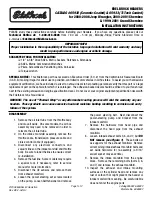
4.4 Battery and Cables
4.4.1 Battery Information
WARNINGS:
It is essential that regular checks are
made to determine that the electrolyte
(acid) levels are correctly maintained.
There is a level indicator in each cell.
Take necessary safety precautions when
handling batteries, for example:
protective clothing, eye and hand
protection.
Ensure batteries are charged in a
designated charging area that is correctly
ventilated.
Vehicles with Start-Stop require an
enhanced battery. You must replace the
battery with one of exactly the same
specification and technology.
Make sure that the battery box is correctly
sealed including any additional cables
routing in and out of the box. the box is
not required for the deep cycle battery
option (A736) but does include drain
tubes. After conversion, always check
that these have not been dislodged.
NOTE:
If a converter intends to add systems or
accessories that will add significant electrical load
(particularly at key off), then vehicles with twin
batteries should be specified. Twin options include
the standard heavy duty system for additional
loads up to 5mA key off load or less than 30A at
engine run or the High Performance Deep Cycle
AGM batteries if greater (option A736). It is also
recommended to upgrade to the 210A alternator
option if the extra loads are continuously active at
engine run and exceed 30A above standard Ford
systems. These loads may inhibit Start-stop
functionality. In addition it is also necessary to
consider the Engine RPM speed control system
(A003), for engine run loads requiring extra high
electrical capacity at idle.
In order to protect the battery system from direct
ground shorts or continuous high current loads, a
350A mega fuse is fitted in the Pre Fuse Box under
the driver’s seat. Converter fit peripherals must not
use this fuse as its sole purpose is protection of
the starting and charging system.
This fuse is not repairable — Use only a Ford
replacement part.
Following battery disconnection, there is no need
to reprogram the vehicle. It retains its ‘normal’
power management settings and configurations.
However, the central locking latches may cycle if
one of these was opened manually in the
intervening period. With regard to the radio, all of
the settings are retained.
There is no longer a need to re-program the
electronic security code, as it is tied into the VIN
of the Factory fit Transit system. The clock
initializes to 1200 and will need to be reset to
correct time in accordance with the customer
handbook procedure. After reconnecting, the
Battery Monitoring Sensor (BMS) requires at least
three hours quiescent period to re-calibrate to the
correct battery state of charge, see also BMS
information later in this section.
The Ford SureStart® system (battery disconnect
relay) prevents inadvertent discharge of the starter
battery to ensure the vehicle will crank. The vehicle
start battery is only connected to the rest of the
systems when the engine is running. During a warm
engine auto stop, the vehicle start battery is
isolated until auto restart is performed.
After market battery management systems are
not required unless for converter fit equipment or
third battery low voltage protection.
Any peripherals added to the power supply must
be connected via the Customer Connection Points
or from dedicated fuses such as the Auxiliary Fuse
Panel (A526) or the High Specification Interface
Connector (A608).
Where twin batteries are required on vehicles with
a single battery installation, the battery disconnect
relay (SureStart® relay), associated wiring and
hardware, should be fitted and aligned to Ford
architecture. The extra battery must be of the
same technology and performance rating as the
existing battery. Alternatively both batteries can
be upgraded to the High Performance Deep Cycle
AGM option (A736).
For special conversions requiring a third battery, a
further disconnect switch is recommended. This
should be controlled via the engine run signal to a
normally open relay. A schematic of this
architecture can be found later in this section.
Refer to: 4.8 Electronic Engine Controls (page 97).
and
Refer to: 4.3 Charging System (page 74).
Battery Voltage Requirements and
Testing
To maximize battery life, at the time of arrival at
the vehicle converter, all batteries must have a
minimum Open Circuit Voltage (OCV) of not less
than 12.5 volts. When the Closed Circuit Voltage
(CCV) is applied, the voltage must not be less than
12.4 volts. This applies to any of the Ford battery
technologies used and applies to both batteries if
a twin system.
All voltages are to be measured with an accuracy
of: + /– 5% of values published using calibrated
meters.
FORD
TRANSIT CUSTOM
2012.75
Date of Publication: 04/2012
4 El
ec
tric
al
80
















































